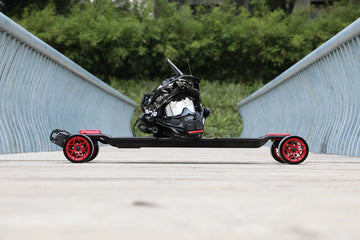The Ultimate User Guide of VESC
Vedders Electronic Speed Controller (VESC) was designed by Benjamin Vedder and is set to revolutionize the electric skateboarding world. However, it can be difficult for many people to understand this technology and how it works, which can prevent some people from taking advantages of the benefits it offers. This VESC users guide was created to make it easy for everyone to understand what VESC is, how it works, and how it compares to other similar technologies on the market.
What Is VESC?
Let’s start by looking at what VESC is. You can think of the VESC unit as a way of controlling the power used by your electric skateboard. You can do an instruction, like increasing the speed and the VESC will relay the instructions to the motors. One of the most significant benefits is that you will be able to set parameters that ensure that the motor operates safely. For example, you can set the maximum power that the engine can use, which will prevent the engine from burning out too early. By controlling these functions, you will be able to protect all the electrical components of your skateboard from getting overworked, ensuring that your electric skateboards will last for longer. There are a few critical factors that you need to understand when setting the safe parameters.
To make sure that you set the controls correctly, you need to understand the difference between voltage and amps. The voltage describes how powerful each component is, while the amp describes how much electricity it is receiving. For example, if you are going up a hill, you will need to increase the number of amps sent to the wheels. The VESC will be able to help you set how high these limits can go, ensuring that a steep incline doesn’t cause you to send too many amps to the wheels, overloading the electrical circuits. Now that we know a little more about this fantastic technology, let’s look at how it was initially discovered.
History of VESC
This technology was initially discovered by Benjamin Vedder, who is interested in robotics and skateboarding. Having found an effective way to regulate his electric skateboard, he made the schematics open source, meaning that anyone from around the world can download and use the plans for free which led many other skateboards to download the plans and use the designs on their skateboards. As they did this, people noticed improvements that could be made to the VESC. They posted this online, fostering the community that has formed around the VESC. Today, hundreds of people work together, using forum sites to improve technology. This constant self-improvement has meant that there have been multiple versions of VESC that have been created.
Versions of VESC
Over time there have been multiple versions of VESC, each one incorporating suggestions from the online community. For example, between version 4.0 and version 4.5, various changes occurred, including re-designing the product and adding a temperature sensor to protect the engine from overheating. Between version 4.5 and version 4.6, the temperature sensor was replaced with a resistor. Later, between versions 4.6 and version 4.7, changes were made to the transistors, allowing the user to manage the flow of electricity around the device effectively. The design was refined again between version 4.7 and version 4.8, where transistors were repositioned to make it more durable. Next, between version 4.8 and version 4.10, new tracers were added. The most significant improvement was changing how the Analog to Digital Converter (ADC) worked with the Serial Peripheral Interface (SPI), allowing users to gather more relevant data, giving them more control of their electric skateboards. Finally, between versions 4.10 and the most up-to-date version, version 4.12, new tracers and capacitors were added. Each new release was accompanied with an update to the firmware.
The firmware allows your computer to communicate with your skateboard. You use the firmware to set the limits on the VESC. For this reason, it’s essential that you keep your firmware updated, as this will allow you to take advantages of new technology. For example, between version 4.8 and version 4.10, the way the skateboard talked to the computer was updated. If users didn’t have the correct firmware, they wouldn’t have been able to gather data on the new sections of the skateboard. Also, each new version allowed users to be able to control more amps safely. For example, version 4.12 could only handle 24 continuous amps safely. The unreleased VESC 6 could be able to control around 50 continuous amps. Now that we know a little more about the types of VESCs you can purchase, let’s look at the differences between the VESC and other types of electronic skateboard controllers.
Comparing VESC With Other ESC
All-electric skateboards must have a way of controlling the electronic component. However, there are many different Electronic Skateboard Controllers (ESC) available on the market, which can make choosing the right one difficult. Often, the best way for prospective users to decide which one suits them best is by looking at the pros and cons of each ESC.
Let’s start by looking at one of the problems that many electric skateboards face. Often, they choose the cheapest model on the market. However, these types of controllers are best suited for electric cars. Because electric cars have smaller engines than skateboard engines, they aren’t equipped to handle the power of the skateboard. This problem is compounded when people stand on the skateboard, adding even more pressure to the engine.
For this reason, these cheap ESCs usually don’t last for a long time. Also, they typically don’t have any built-in safety features, meaning that they can place the rider’s safety at risk. Also, because they don’t have any protection for the electronic components in the skateboard, they might damage your electric skateboards. For these reasons, it’s recommended that you don’t use these types of ESCs.
Though there are many other types of ESCs you can purchase, you should consider how much control they offer you. One of the biggest reasons why people like VESC is because its plans are available online, meaning people can fully customize it, changing it to suit their skateboard and their needs. If choosing another type of ESC, though, you will be limited in how much you can control. Look at the amount of the number of battery cells it offers, which affects the amount of power that can be supplied to the skateboard. While the VESC will allow you to add as many cells as you want, other ESCs will limit the number of cells that they can support. Look for the amount of amps it can supply, which will determine how long you can travel and will determine the type of skateboard you purchase. Usually, this number is provided in ampere-hours (Ah). For example, if you get a 10Ah skateboard, you need a ten-amp battery to travel for an hour. The distance you can travel varies depending on the number of amps you use. You might also want to consider the amount of noise produced. It can be irritating to skate with a loud ESC. While many VESCs are silent, some other types of ESC will produce an annoying sound. Now that we know the factors to consider when using a store-bought ESC let’s look at some of the benefits of using a VESC.
There are many reasons why you might want to consider buying a VESC for your electric skateboards. First, as we discussed, you can customize it to suit your skateboard and style. For example, if you want to travel for long distances, you can make sure that you have enough battery storage to make the journey. Also, VESC tends to be very compact, meaning it’s suitable to use, even on slim skateboards. Another significant benefit is the protection it provides, ensuring you don’t damage your electric components. For example, it has temperature control built-in, preventing it from getting too hot. The VESC is known for these high-tech features. For example, many models feature regenerative braking and the ability to program acceleration curves. Finally, the braking systems are highly effective. They will stop the skateboard quickly, without a sudden jerking motion that can send some riders off the board. However, there are some disadvantages to using this system.
The VESC system has a few negatives. First, though it’s easy to get set-up, there are some complex elements that users can explore if they want to improve their performance. Also, you will still need to be careful about which VESC you purchase. Not every VESC is made equally; some will offer users better performance than other models. Using this understanding of the benefits and disadvantages of VESC, you can decide if this ESC is suitable for you.
What Type of People Should Buy a VESC?
As we’ve seen, VESC is one of the best types of ESC available on the market. Therefore, anyone who enjoys electric skateboards can benefit from using a VESC on their board. However, some groups might receive more benefits from the VESC. You might get more benefit from this ESC if you enjoy the technology associated with skateboarding. You will get the most benefits if you are willing to delve into the technical elements to optimize them to your skateboarding style.
How to Choose the Best VESC for Your Skateboard?
There are multiple types of VESC available on the market, so it can be challenging to find the best one to suit your skateboard. However, there are some crucial aspects to consider. First, you should consider how much power you will require. Often different types of VESCs will supply different levels of energy. Also, you should find the size of the VESC and how well it will suit your skateboard.
Moreover, look at the amount of battery storage it can supply. To find the best type of VESC, read online reviews, which will tell you how satisfied other people were with the product. Once you’ve selected the best VESC, you need to make sure that you choose the right firmware and connect it to the skateboard, which can be a tricky process, which is why we’re going to look at it in this VESC user guide.
When you’ve purchased your VESC, you need to download the corresponding firmware to your computer, allowing you to connect your skateboard to your laptop. There are multiple types of firmware, which will suit all the major operating systems. If you don’t choose the right firmware, you will receive an error message when you try to connect it to the skateboard. Once you’ve downloaded firmware, you can connect your skateboard to the computer, allowing you to configure the settings, making sure that everything is working properly. During this process, it’s recommended that you connect the VESC to a reliable source of power. Many sources recommended a regulated type of energy, especially when you power it up for the first time, which will protect the VESC. Finally, on the screen, you will be shown two options for connecting to your VESC. Choose to connect via USB. Once this procedure has been completed, you can configure the VESC, allowing you to change the settings to suit your needs.
Conclusion
Many people enjoy using their electric skateboard. However, to be valid, you will need an effective way of sending your commands to the motor. To do this, many people choose to use VESC. In this VESC users guide, we discussed what this technology is, some of the benefits it offers and how to get it set-up correctly. Hopefully, this has helped you answer any questions you had about this technology. So, choose and install a VESC on your electric skateboards today.


